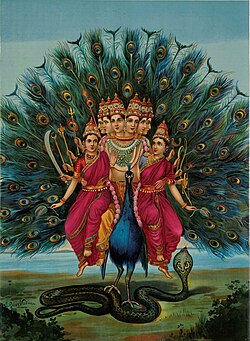This article needs additional citations for verification. (December 2022) |
| Kukke Subramanya Temple | |
|---|---|
Kukke Sri Subramanya Temple | |
 The Gopura of the Temple | |
| Religion | |
| Affiliation | Hinduism |
| District | Dakshina Kannada |
| Deity | Kartikeya as a Nāga |
| Festivals | Shasti, Kiru Shasti, Nagara Panchami, Nagaradhane |
| Location | |
| Location | On banks of river Kumaradhara |
| State | Karnataka |
| Country | |
 | |
| Geographic coordinates | 12°40′N 75°37′E / 12.66°N 75.61°E |
| Architecture | |
| Style | Architecture of Karnataka |
| Creator | Parashurama |
| Website | |
| itms.kar.nic.in/.. | |
| Part of a series on |
| Kaumaram |
|---|
 |
|
|
Kukke Subramanya (IAST: Kukke Subrahmaṇya) is a Hindu temple on the banks of Kumaradhara River in the village Subramanya in Kadaba taluk (previously in Sullia taluk) in Dakshina Kannada district, Karnataka, India.[1] Kartikeya is worshipped as Subramanya, lord of all serpents in the temple. Epics say that the divine serpent Vasuki and other serpents found refuge under Subramanya when threatened by the Garuda.The Koojugodu Kattemane family served as the chief administrators of the Kukke Shree Subramanya Swamy temple, managing it and exercising its chief administrative authority for generations from The Ikkeri Nayakas period until Encroachment.
The priests in the temple are Shivalli Madhwa Brahmins. The poojas and other daily rituals in the temple are performed as per Madhvacharya's Tantra Sara Sangraha.[2]


Legend
[edit]According to legend, Kukke Subramanya is one of the seven sacred sites established by Saint Parashurama. It is the location where the divine serpent Vasuki sought refuge in Kukke Subramanya to escape Garuda, the celestial bird and vehicle of Lord Vishnu. It is believed that Lord Kumaraswamy and his brother Lord Ganesha defeated the demon rulers Tharaka and Shura Padmasura at Kumara Parvatha, near Kukke Subramanya. Following his victory, Lord Kumaraswamy married Devasena, the daughter of Indra, in a grand ceremony attended by major deities, who blessed the place with divine energy.[1]
Koojugodu Kattemane Family and their Authority
[edit]The Koojugodu Kattemane family was a prominent Gowda lineage of the Arebhashe Vokkaliga Gowda community that historically served as the Sankesha Adhikaris(chief administrators) of the Kukke Subramanya Temple[3]. They traced their ancestry to Thimma Nayaka of Ikkeri and maintained close ties with both the Haleri Maharajas of Kodagu and the Dakshinayana Sringeri Sharada Peetam. The family played a key role in temple management, religious service, and establishing associated shrines within the temple premises.
The family served as the chief administrators of the temple, managing it and exercising its chief administrative authority for generations[3].
They belonged to the Nayar Bali gothra of the Arebhasé Vokkaliga Gowda community and traced their ancestry to Thimma Nayaka of Ikkeri, a member of the Ikkeri royal family. The Nayakas of Ikkeri were rulers who performed seva (service) to Lord Subramanya[3].
The Ballala of Rathnapura, who ruled parts of Kukke Patana, Harihara, Balgodu, Anekki, and Kollamogru, came into conflict with Thimma Nayaka’s lineage. After a confrontation that ended the Ballala’s rule, authority over the Kukke Subramanya temple passed directly to the Koojugoodu Kattemane chieftains[3].
The Haleri Maharajas of Kodagu were blood relatives of the family[3].The Koojugodu Kattemane Family was of Lingayat origin, later got converted to Arebhase Vokkaliga Gowdas[3].The two lineages shared political, cultural, and religious ties, including agreements to exchange offerings between the Kukke Subramanya Temple in Dakshina Kannada and Shree Bhagandeshwara Temple, Bhagamandala in Kodagu[3].
The family maintained close spiritual ties with the Ubhaya Jagadgurus of the Dakshinayana Sringeri Sharada Peetam[3]. Guided by the Jagadguru, they established the Shree Chandramouleshwara Temple and a Sringeri Mutt within the Kukke Subramanya temple premises. The Shiva Linga in the Chandramouleshwara temple was installed by the Koojugoodu Kattemane family. They continue to preserve the Nirupa (written order) and Kanchina Belé (brass plaque) presented by the Jagadguru[3].
Notable members include:
- Shri Shanthappa Gowda[3]
- Shri Kushalappa Gowda[3]
- Shri Venkataramana Gowda (popularly K. V. Gowda, MLA of Puttur)[3]
- Shri Subrahmanya Gowda (MLA of Puttur and Belthangady)[3]
Although the family lost administrative control when the temple was taken over by the Karnataka Endowment Department[3], they remain recognized as one of the most powerful and philanthropist Gowda families associated with Kukke Subramanya Temple[3].
Popular rituals
[edit]The Ashlesha Bali Puja, a ritual seeking protection from black snakes, and the Sarpa Dosha Parihara, performed to remove curses associated with the snake god, are two of the most popular puja rituals conducted at the Kukke Subramanya Temple.[1]
See also
[edit]- Ghati Subramanya Temple
- Kartikay
- Kartikkeya
- Udupi
- Subramanya Matha
- Dharmasthala
- Sullia
- Mangalore
- Saarvajanika Nagabrahmastana Moodanidambooru, Bannanje
References
[edit]- ^ a b c "Kukke Subramanya Temple". Karnataka Tourism, Govt of Karnataka.
- ^ Karnataka State Gazetteer: Shimoga. Director of Print, Stationery and Publications at the Government Press, Karnataka (India). 1973. p. 105.
- ^ a b c d e f g h i j k l m n o Puttur Anantharaja Gowda. In Pursuit of Our Roots. Bengaluru: Tenkila Publications, First Edition, 23 February 2015. Available at: Archive.org
- ^ Puttur Anantharaja Gowda. In Pursuit of Our Roots. Bengaluru: Tenkila Publications, First Edition, 23 February 2015. Available at: Archive.org
External links
[edit]- Temple's Official Website Archived 18 November 2012 at the Wayback Machine